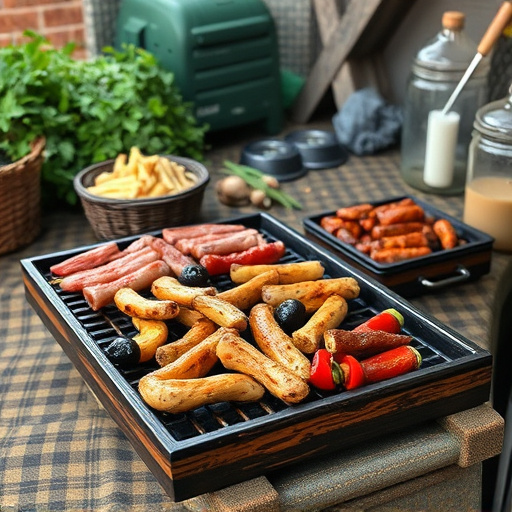Crafting the perfect BBQ Beef Brisket Recipe involves a science of low and slow cooking (225°F – 250°F or 107°C – 121°C) to break down tough fibers into tender meat. Key steps include trimming fat, seasoning with salt, pepper, or spice blends, and smoking over wood chips like oak, hickory, or mesquite. Regular temperature checks are crucial. Resting and slicing against the grain enhance tenderness. Serve with sides like coleslaw, beans, cornbread, or veggies for a robust BBQ experience.
Unleash the mouthwatering flavors of perfectly cooked BBQ beef brisket with this comprehensive guide. From understanding the cut’s unique characteristics to mastering low and slow cooking techniques, we’ll walk you through every step. Learn how to set up your BBQ for optimal results, select the best marinades and rubs, and master smoking techniques. We’ll also cover temperature measurement, resting, slicing, and delicious serving suggestions, turning you into a brisket master in no time. Discover the art of crafting a savory BBQ beef brisket recipe!
- Understanding Brisket: The Cut and Its Characteristics
- The Science Behind Low and Slow Cooking
- Setting Up Your BBQ for the Perfect Roast
- Marinades and Rubs: Enhancing Flavor
- Smoking Techniques for Savory Results
- Measuring Temperature: Ensuring Optimal Cooking
- Resting and Slicing: The Final Touches
- Accompaniments and Serving Suggestions
Understanding Brisket: The Cut and Its Characteristics
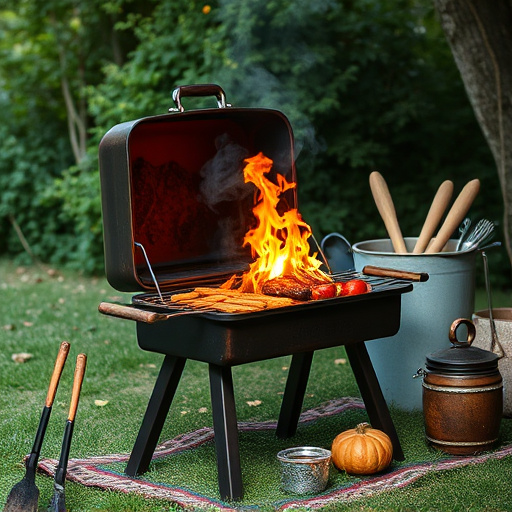
Brisket, a cut of meat from the breast of a cow, is a favorite among barbecue enthusiasts for its rich flavor and tender texture when cooked properly. When considering a BBQ beef brisket recipe, understanding this particular cut is key. Brisket has distinct characteristics that make it both challenging and rewarding to cook; its two main muscles, one thin and one thick, require careful preparation to ensure even cooking and maximum tenderness.
The exterior of the brisket features a thick layer of fat, often referred to as the fat cap, which plays a crucial role in retaining moisture during the low-and-slow cooking process typical for this cut. This method—slow cooking at low temperatures—is what transforms the tough muscle fibers into a delectable, melt-in-your-mouth dish. A well-cooked brisket is a testament to patience and precision, making it a favorite among those who appreciate the art of BBQ beef brisket recipes.
The Science Behind Low and Slow Cooking
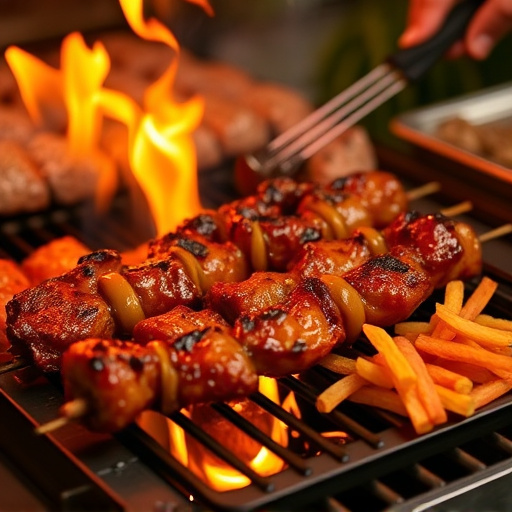
The art of low and slow cooking is a science in itself, particularly when it comes to crafting the perfect BBQ Beef Brisket recipe. This method involves cooking meat at low temperatures for an extended period, allowing it to break down collagen into gelatin, which makes the brisket tender and juicy. The process begins with proper muscle fiber alignment, ensuring that the brisket cooks evenly. As time passes, the heat gently carves through the connective tissues, transforming tough cuts like brisket into delectable, melt-in-your-mouth treats.
This slow and steady approach also helps to intensify flavors. The low temperature allows for a gradual release of natural juices, creating a rich, savory profile that permeates every slice. Additionally, the slow cooking process enables the development of complex flavors through the Maillard reaction, responsible for the desirable brown crust and tantalizing aromas associated with perfectly cooked BBQ Beef Brisket.
Setting Up Your BBQ for the Perfect Roast
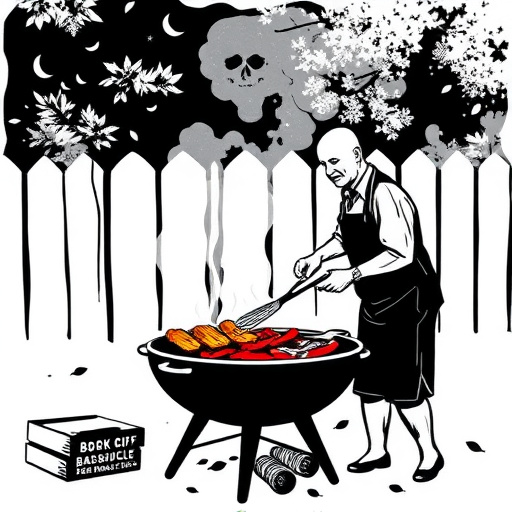
To achieve the perfect slow-cooked BBQ beef brisket, setting up your BBQ is crucial. Start by selecting a reliable smoker that offers consistent temperature control, such as a charcoal or gas grill designed for low-and-slow cooking. Line the smoker with heavy-duty aluminum foil or use a smoking wood chip tray to enhance flavor. Ensure your BBQ is set to a low temperature—ideally between 225°F and 250°F (107°C to 121°C)—for the best results. This method allows for even cooking and tenderizes the brisket over time.
Prepare your BBQ beef brisket recipe by removing any excess fat from the meat, leaving a thin layer for moisture and flavor. Rub the brisket with a generous amount of salt and pepper or a favorite spice blend to enhance its natural taste. Place the brisket in the smoker, fat side up, ensuring even heat distribution. Keep an eye on the temperature and adjust as needed while the meat slowly cooks, transforming into a tender, mouthwatering delight.
Marinades and Rubs: Enhancing Flavor
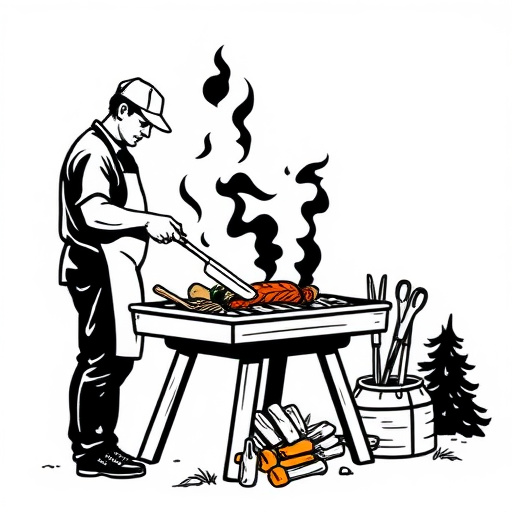
Marinades and rubs are essential elements in the quest for the perfect BBQ beef brisket recipe. They significantly enhance the flavor and can transform an ordinary cut of meat into a mouthwatering delicacy. A good marinade, with its combination of acids, oils, and spices, penetrates deep into the brisket, tenderizing it as it infuses each molecule with rich, smoky flavors.
When crafting your own marinade or rub, think about balancing sweet, tangy, savory, and spicy notes. Common ingredients include brown sugar, salt, pepper, garlic, paprika, and a variety of herbs like thyme and rosemary. These not only add depth but also help to break down the brisket’s tough connective tissues during the slow-cooking process, ensuring a tender, juicy final product.
Smoking Techniques for Savory Results
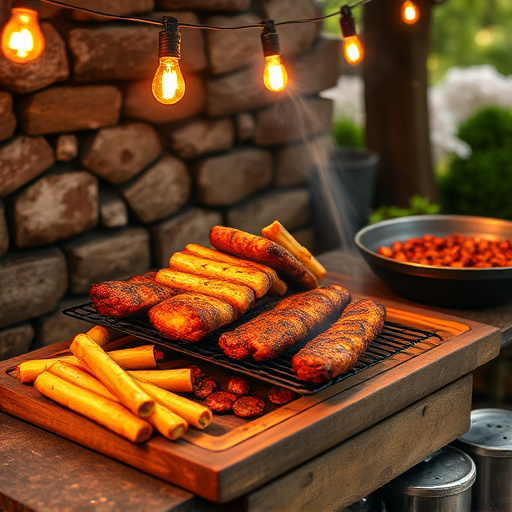
Smoking is a key technique to achieve that mouthwatering, savory result in your BBQ beef brisket recipe. The process involves slowly cooking the meat at low temperatures, usually between 107°F to 225°F (42°C to 113°C), over smoke generated from burning wood chips or chunks. Popular woods for brisket include oak, hickory, and mesquite, each imparting a unique flavor profile.
For optimal results, maintain a steady, low temperature in your smoker. This can be achieved by controlling the amount of wood chips you add to keep the fire going. Regularly checking and maintaining your smoker’s temperature ensures even cooking. The slow smoking process breaks down tough muscle fibers in the brisket, making it incredibly tender and juicy when properly prepared.
Measuring Temperature: Ensuring Optimal Cooking
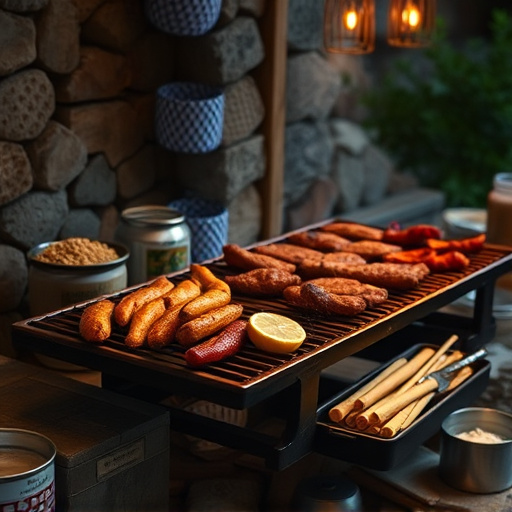
Accurately measuring the temperature of your brisket is key to achieving the perfect BBQ beef brisket recipe. Throughout the low and slow cooking process, maintaining a consistent internal temperature allows for even cooking and prevents over or undercooking. Investing in a reliable meat thermometer inserted into the thickest part of the brisket is essential. Ideal cooking temperatures range between 225°F to 250°F (107°C to 121°C), allowing for slow, steady growth of flavors while keeping the meat tender and juicy. Regular temperature checks ensure optimal results, helping you make informed adjustments to your cooking strategy along the way.
Resting and Slicing: The Final Touches

After patiently cooking your BBQ beef brisket recipe low and slow, the next crucial step is resting and slicing. This allows the juices to redistribute throughout the meat, ensuring every bite is tender and flavorful. Typically, a rest period of 30-60 minutes is recommended before slicing. During this time, the brisket continues to cook gently from the residual heat, further enhancing its texture and taste.
When it’s time to slice, against the grain is the preferred method. This technique ensures that each slice is both tender and lean. Using a sharp knife, carefully cut the brisket into thin slices, starting from one end and working your way through. Resting and slicing properly will transform your delicious, slow-cooked brisket into a culinary masterpiece, satisfying any BBQ Beef Brisket lover’s cravings.
Accompaniments and Serving Suggestions
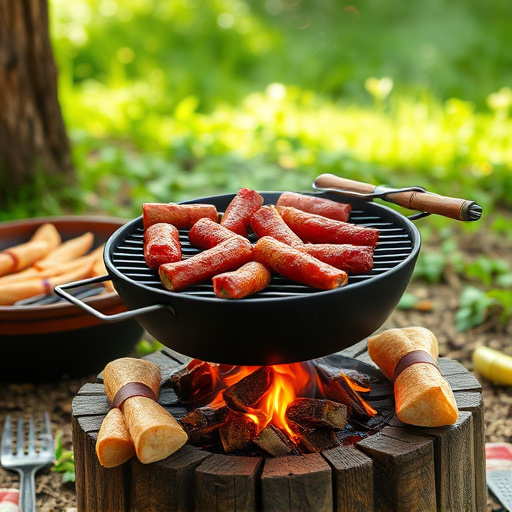
When serving your mouthwatering BBQ beef brisket recipe, there are several accompaniments that complement its rich flavor profile. Classic sides like coleslaw and baked beans never go out of style, offering a balance to the slow-cooked meat’s depth. For an extra kick, consider adding some well-seasoned cornbread or crispy potato wedges. If you’re aiming for a more robust meal, pair it with a hearty vegetable dish like roasted carrots or grilled asparagus.
For an ultimate BBQ experience, serve your brisket on a toasted bun with a drizzle of barbecue sauce and a sprinkle of chopped onions or cilantro. This simple serving suggestion lets the quality of the meat shine while allowing guests to customize their plate with their preferred condiments. Don’t forget that the right accompaniments can transform a good meal into an exceptional culinary journey, making your BBQ beef brisket recipe a true standout.
